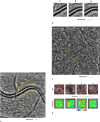Retinal Vascular Diseases Highlighted by Adaptive Optics Ophthalmoscopy
- PMID: 40698101
- PMCID: PMC12277986
- DOI: 10.22336/rjo.2025.37
Retinal Vascular Diseases Highlighted by Adaptive Optics Ophthalmoscopy
Abstract
Objective: Our objective was to assess retinal microcirculation and photoreceptor parameters in both healthy individuals and patients with vascular retinal diseases using adaptive optics ophthalmoscopy. This technology enhances optical system resolution to 2 µm by correcting wavefront aberrations, revolutionizing in vivo studies of ocular structures.
Materials and methods: Our study examined the clinical applications of adaptive optics in both healthy individuals and patients with vascular retinal diseases, including nonproliferative diabetic retinopathy, proliferative diabetic retinopathy, and macular telangiectasia (MacTel) type 2.
Results: In our study, we observed a higher wall-to-lumen ratio (WLR) value in our patient with proliferative diabetic retinopathy compared to our healthy volunteer. Additionally, we found a positive correlation between WLR and the severity of diabetic retinopathy. Furthermore, cone density was lower in all quadrants of our patient with proliferative diabetic retinopathy. For our patient diagnosed with MacTel type 2, the cone mosaic appeared irregular and blurred, with notable cone loss, especially on the temporal side of the macula, consistent with the typical location of MacTel type 2 lesions.
Discussion: Adaptive optics imaging assesses retinal changes in vascular diseases despite acquisition challenges. The obtained images aid in tracking the progression of diabetic retinopathy and detecting early changes of MacTel Type 2. Our study highlights both vascular and photoreceptor changes, quantifying these parameters to enhance the understanding of these vascular diseases.
Conclusions: Adaptive optics imaging is an advanced technique that provides high-resolution visualization of the microstructure of retinal vasculature and photoreceptors. This technology enhances our understanding of both healthy and vascular retinal conditions, aiding in diagnosis, monitoring, and prognosis.
Keywords: AO = adaptive optics; BCVA = best corrected visual acuity; DR = diabetic retinopathy; FC = fundus cameras; LD = lumen diameter; MacTel = macular telangiectasia; OCT = optical coherence tomography; ROI = regions of interest; SHWS = Shack-Hartmann wavefront sensor; SLO = scanning laser ophthalmoscopy; TD = total vessel diameter; WCSA = wall cross-sectional area; WLR = wall-to-lumen ratio; WT = wall thickness; adaptive optics; retinal vascular diseases.
© 2025 The Authors.
Conflict of interest statement
The authors declare that they have no conflict of interest.
Figures




References
MeSH terms
LinkOut - more resources
Full Text Sources
Medical
Research Materials
